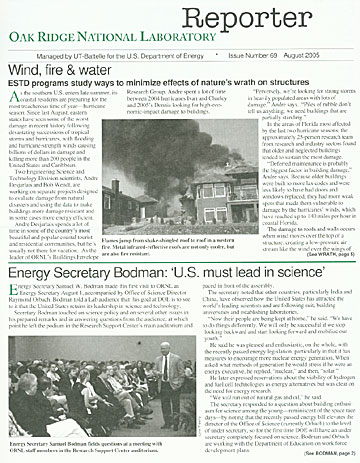| Number 69, August 2005 |
 |
 Wind, fire & water
Wind, fire & water
ESTD programs study ways to minimize effects of nature’s wrath on structures
 |
| Flames jump from shake-shingled roof to roof in a western fire. Metal infrared-reflective roofs are not only cooler, but are also fire resistant. |
As the southern U.S. enters late summer, its
coastal residents are preparing for the most treacherous time of year—hurricane season. Since last August, eastern states have seen some of the worst damage in recent history following devastating successions of tropical storms and hurricanes, with flooding and hurricane-strength winds causing billions of dollars in damage and killing more than 200 people in the United States and Caribbean.
Two Engineering Science and Technology Division scientists, Andre Desjarlais and Bob Wendt, are working on separate projects designed to evaluate damage from natural disasters and using the data to make buildings more damage resistant and in some cases more energy efficient.
Andre Desjarlais spends a lot of time in some of the country’s most beautiful and popular coastal tourist and residential communities, but he’s usually not there for vacation. As the leader of ORNL’s Buildings Envelope Research Group, Andre spent a lot of time between 2004 hurricanes Ivan and Charley and 2005’s Dennis looking for high-economic-impact damage to buildings.
“Perversely, we’re looking for strong storms in heavily populated areas with lots of damage,” Andre says. “Piles of rubble don’t tell us anything; we need buildings that are partially standing.”
In the areas of Florida most affected by the last two hurricane seasons, the approximately 25-person research team from research and industry sectors found that older and neglected buildings tended to sustain the most damage.
“Deferred maintenance is probably the biggest factor in building damage,” Andre says. Because older buildings were built to more lax codes and were less likely to have had doors and windows replaced, they had more weak spots that made them vulnerable to damage by the hurricanes’ winds, which have reached up to 140 miles per hour in coastal Florida.
The damage to roofs and walls occurs when wind moves over the top of a structure, creating a low-pressure air stream like the wind over the wings of an airplane. With an airplane, the pressure differences result in the lift that makes the plane fly. With a building, the roof will remain in place until something else gives way that changes the air pressure inside the building, like a window or door breaking. The combination of the wind uplift and pressurization rips the roof off the structure.
“That’s why people board up their windows and doors—their failure prompts the majority of wind damage to structures,” Andre says. The worst design elements are the big doors at loading docks where big trucks can load and unload, Andre says. Architectural accessories like doors, windows, vents and other openings are a lot less wind-resistant than walls. He adds that shoddy construction is often to blame.
“Where roofers say they’re going to use one nail every two inches and really use half that many . . . when people try to cut corners, it really weakens the integrity of buildings,” Andre says.
Old buildings are generally more susceptible to damage as well, because they were usually built to fewer standards and codes, which outline the standards of strength to which buildings must be constructed. States like Florida are divided into bands according to the intensity of hurricane-related winds likely to cross them, with southern and eastern coastal areas in the bands requiring more stringent building codes than inland and northern areas of the state.
“As we learn more, it affects the way we build,” Andre says. The private-sector participants are currently drafting a report compiling all of the information gathered during the research. After possibly investigating one or two more storms, the group will finish the report and the data hopefully will be considered for changes in codes.
Although hurricanes contain an enormous amount of energy, flooding does the most expensive natural-disaster damage to structures in the United States. Residents of coastal and low-lying areas throughout the country can be especially hard-hit by storms, seasonal rains and winter thaws are also faced with a catch-22 when it comes to building requirements—there are no certified flood-resistant materials on the market, yet the latest building codes often require them for buildings in high-flood-risk areas.
Bob Wendt has headed up a collaborative project, sponsored by DOE, FEMA and HUD, aimed at bringing together government and private-sector building experts to assess the use of ongoing energy-efficiency research and to help reduce the risk of natural-disaster damage to houses.
The major task of those involved with Bob’s project is “coupling energy efficiency with natural-disaster mitigation,” Bob says. The two goals are a natural fit—many of the construction materials already available to builders work well to reduce damage by flooding and wildfires.
Bob and a group of collaborators at Tuskegee University have been examining the use of spray polyeurethane foam (SPUF) for wall insulation and as a sealant. Although SPUF has a higher insulation value than fiberglass insulation, it costs significantly more.
“Current energy prices do not provide enough incentive to switch to the higher priced insulation based on energy savings alone,” Bob says. “But if using SPUF in a flood-prone home eliminated the need to tear the house apart after a flood to replace the waterlogged insulation, then it would save the homeowner or insurer a lot of money and easily justify its higher cost.”
Flooded fiberglass also dries out slowly, releasing moisture into the surrounding air and structure and potentially promoting mold growth. SPUF, on the other hand, isn’t permeated by the water and so it doesn’t encourage mold growth. In the test structures at Tuskegee, flood-related mold and mildew growth in structures built with SPUF was far less than that in fiberglass structures.
|
Low-energy windows are a good idea on multiple levels. The windows reflect radiant heat from the sun, and in the event of an external fire, can prevent radiant heat waves from penetrating the glass and igniting materials inside the house. |
Tightly sealed doors and windows, which can stave off floodwaters for longer than warped or ill-fitting ones, also reduce the amount of air exchange between the inside and outside of a structure. With reduced air exchange, heating and cooling systems become more efficient as well.
The Tuskegee and ORNL researchers have compiled their research into a report they will present at the National Floodplains Conference in West Virginia on September 13. Hopefully, Bob says, there will soon be certified flood-resistant materials on the market. “The (building) code is begging this issue,” he says.
Another area of synergy between energy efficiency and disaster mitigation is reducing wildfire damage. Each summer major wildfires occur in dry areas, destroying thousands of homes.
Metal infrared-reflective (IR) roofs are not only successful reflectors of infrared light, keeping attics and spaces underneath cool, but are also a convenient fire-resistant material that can replace wood and tar shingling in fire-prone areas.
Low-energy windows are a good idea on multiple levels. “Lower-e windows are an energy strategy that enhances fire protection,” Bob says. He explains that the windows reflect radiant heat from the sun, and in the event of an external fire, can prevent radiant heat waves from penetrating the glass and igniting materials inside the house.
|
Flooding does the most expensive natural-disaster damage to structures in the United States. |
Bob also suggests that eliminating vents from crawlspaces and attics would further enclose the thermal envelopes of structures, providing fewer openings by which wildfires can enter. These changes are also being pursued by DOE as a means of increasing the energy efficiency of new homes.
Overall, energy efficiency and disaster mitigation go hand-in-hand, with few objections. Energy saving technologies won’t present a disadvantage in the event of catastrophic weather, such as a tornado.
“People might blame energy-efficient structure, thinking that a more airtight house will allow more pressure to build up inside more rapidly,” Andre says. “We’ve found no evidence of that.”
He says that combining commercial and governmental sectors during research presents multiple advantages. The manufacturers can evaluate how their materials are performing, and the government can serve as an objective overseer of the evaluations of energy-efficient materials.
“The federal government doesn’t have anything to sell . . . we want to be sure we’re not telling people to do anything that would be unwise,” Andre says.—Eva Millwood
 Energy Secretary Bodman: ‘U.S. must lead in science’
Energy Secretary Bodman: ‘U.S. must lead in science’
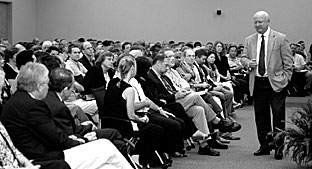 |
| Energy Secretary Samuel Bodman fields questions at a meeting with ORNL staff members in the Research Support Center auditorium. |
Energy Secretary Samuel W. Bodman made his first visit to ORNL as
Energy Secretary August 1, accompanied by Office of Science Director Raymond Orbach. Bodman told a Lab audience that his goal at DOE is to see to it that the United States retains its leadership in science and technology.
Secretary Bodman touched on science policy and on several other issues in his prepared remarks and in answering questions from the audience, at which point he left the podium in the Research Support Center’s main auditorium and paced in front of the assembly.
The secretary noted that other countries, particularly India and China, have observed how the United States has attracted the world’s leading scientists and are following suit, building universities and establishing laboratories.
“Now their people are being kept at home,” he said. “We have to do things differently. We will only be successful if we stop looking backward and start looking forward and mobilize our youth.”
He said he was pleased and enthusiastic, on the whole, with the recently passed energy legislation, particularly in that it has measures to encourage more nuclear energy generation. When asked what methods of generation he would stress if he were an energy executive, he replied, “nuclear,” and then, “solar.”
He later expressed reservations about the viability of hydrogen and fuel cell technologies as energy alternatives but was clear on the need for energy research.
“We will run out of natural gas and oil,” he said.
The secretary responded to a question about building enthusiasm for science among the young—reminiscent of the space race days—by noting that the recently passed energy bill elevates the director of the Office of Science (currently Orbach) to the level of under secretary, so for the first time DOE will have an under secretary completely focused on science. Bodman and Orbach are working with the Department of Education on work force development plans.
Bodman noted his relatively few months on the job and said his visit, which nearly completed his tours of the DOE sites, was mainly to learn about DOE and its issues.
“DOE is not the best managed organization I have ever encountered,” he said, giving the agency’s organizational stovepiping and poor communication across organizations as examples of areas he would like to improve.
The secretary also noted that DOE has problems bringing in projects on time and within cost, although he earlier, in a media session, praised the Spallation Neutron Source for being “on time, on schedule and on budget.”
“Ray Orbach expressed his enthusiasm for the SNS. Now that I’ve seen it, I can understand why. It’s a very impressive facility. This is big science,” he told the media group.
Bodman said at the employee meeting that he was “smitten by the scale” of the SNS and Center for Nanophase Materials Sciences, also on Chestnut Ridge. “It was larger and more imposing than I had thought.”
The Energy Secretary recalled that many of his teachers spent time at Oak Ridge, particularly during the Manhattan Project days, and that he had “great reverence” for Oak Ridge’s history. He expressed as much enthusiasm for the future. Citing the Lab’s relationships with leading universities such as Georgia Tech, and in how technology transfer between government, universities and the private sector will drive the economy, he said ORNL has become a “beacon of hope” for the region and for the country.
The secretary’s itinerary included visits to the SNS and the CNMS, as well as to the Center for Computational Sciences’ National Leadership Computing Facility.—Bill Cabage
 New Bethel Valley Road barriers
‘kinder, gentler’ way to snare intruders
New Bethel Valley Road barriers
‘kinder, gentler’ way to snare intruders
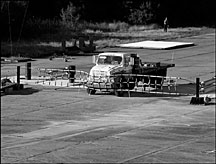 |
| In this vendor demonstration photo, a truck encounters the net of a Ground Retractable Automobile Barrier similar to the pair being installed this summer on Bethel Valley Road. |
This summer ORNL commuters have been
winding their way around two construction projects on Bethel Valley Road in addition to the roundabout going in at the main visitor entrance. Active vehicle barrier systems, called Ground Retractable Automobile Barriers, or GRABs, are being added to both the east and west ends of Bethel Valley Road, just past the vehicle entrances.
The addition of the new vehicle barriers is in response to DOE’s Design Basis Threat, says the Laboratory Protection Division’s Randy Stanfield. Once installed, the new vehicle barriers will be operated by ORNL’s Protective Force as directed by the Laboratory Protection Division.
The GRABs essentially ensnare a vehicle, which can be as big as a semi truck, in a cable net that can be deployed by the Protective Force if the vehicle crashes the entrance.
In the selection process of the barriers, the safety of Lab personnel and visitors was a prime consideration, Randy says.
Most readily available vehicle barriers designed to withstand the impact of heavy, high-speed vehicles are hard barriers, consisting of heavy plate steel wedges or bollards that basically destroy the vehicle in the collision and often result in serious injury or death to the vehicle occupants. Convinced that this type barrier would never be acceptable on Bethel Valley Road, the ORNL Security Systems team researched the market and located an alternative design.
Using a net made of steel cables and mounted on piston-type shock absorbers, the GRAB can bring vehicles to a halt in a “kinder, gentler” fashion, resulting in only minor damage to the vehicle depending primarily upon vehicle speed and weight and significantly less likelihood of injury to the occupants, Randy says. In addition to the energy-absorbing design, each of the barriers will be equipped with traffic signals and audible warnings that will be activated several seconds before the barrier is deployed, engineered to provide adequate time for vehicles to stop before reaching the deployed barrier.
While the net can be deployed in a matter of seconds, it normally lies flat in a grooved rubber pad recessed into the pavement.
Attractiveness was also considered in the selection and design of the GRAB. Most of the heavy-duty hardware that does the work of raising the net and absorbing the energy of speeding vehicles will be hidden under attractive, faux stone covers, designed to mimic the existing stonework at the portals.
The barriers are located on the Laboratory side of the Bethel Valley Road entry portals within the 45 mph speed zone. Other than for testing, the deployment of the Bethel Valley Road Vehicle Barriers is expected to be a very rare occurrence. Following the traffic signals should be all that is required to keep well-intentioned drivers on Bethel Valley Road from experiencing a “close encounter” with these new devices designed to provide ORNL with an additional layer of security.—B.C.
 The total Wigner
The total Wigner

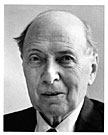 |
|---|
|
Eugene Wigner |
One of ORNL’s most accessible treasures may be “The Collected Works of Eugene Paul Wigner,” an eight-volume series that contains his considerable scientific papers in five volumes and three volumes of often fascinating historical, philosophical and socio-political papers.
“None of the librarians who work the desk can recall anyone wishing to see the volumes other than the three people involved in the ORNL History Room project,” says History Room volunteer and retired Metals & Ceramics Division Director Jim Weir.
Jim’s co-volunteers in the History Room are Charles Congdon and Bill Yee.
Wigner was ORNL’s first scientific director and arguably the most famous scientist directly associated with the Lab. He knew and studied and worked with the science giants of the 20th century including Albert Einstein, Enrico Fermi, Leo Szilard, John von Neumann and Edward Teller.
Wigner’s recollections of Einstein, in fact, seem to indicate that Einstein’s glory days were at physics colloquia he attended and organized at the University of Berlin in the early 1920s. Wigner implies that Einstein’s poor grasp of English isolated him after his hegira to the United States and Princeton in the 1930s.
A 1986 article by David Sundberg taken from the Oak Ridger describes Wigner’s conceptual role in the Manhattan Project. On the strength of the famous letter to President Roosevelt that Wigner and Szilard convinced Einstein to sign warning of a Nazi bomb, the Hungarian pair were invited to plead for funding before a panel of military officers. One colonel dismissively told Wigner and Szilard not to worry, “because wars are not won by weapons but by the morale of the civilian population.”
The humble and polite Wigner rose and stated, “Colonel, if that is so, let us disband the army and spread its wonderful morale among the civilian population.”
Point made, Wigner then requested the grand sum of $6,000.
The collected works, besides their very dense scientific content, include his thoughts on the neutron’s significance, the atom bomb, relativity and the future of science as he saw it. The volumes also contain his memoirs and impressions of such greats as Fermi, Einstein, von Neumann and the mathematician Paul Dirac, his prickly brother-in-law.
The eight volumes reside in a special collections cabinet near the reference desk. Check it out and see what ORNL’s most famous scientist was all about.
 Software gets seal of approval
Software gets seal of approval
Anywhere that special nuclear material is stored, the container must bear a seal that serves as a tamper-indicating device. Figuring out which kind of a seal to use isn’t simple—it depends on the type of container, the levels of security that exist, the environment, the type of material being secured, safety issues, ease-of-use conditions, and how often it will be replaced, among other parameters. A seal can be anything as ordinary as a piece of adhesive tape or as sophisticated as a fiber-optic device.
A project team led by Chris Pickett from the Nuclear Science & Technology Division with substantial support from Dave Richardson of Computational Sciences and Engineering Division is, this month, unveiling the “Seal Selection Tool” software. This software represents the first effort within the DOE-NNSA community to provide tamper-indicating- device administrators immediate access to seal performance data collected from stringent DOE-NNSA designed tests.
This tool will help TID administrators, who are responsible for determining the best seal to use for their specific applications, make more informed decisions. All they’ll need to do is prioritize the parameters of importance for their specific application and the software will spit out a list of tested seals that best meet their needs.
“For example, some seals must operate in harsh environments and must maintain their integrity for many years,” Chris says. “Others may be in fairly benign locations or might be changed often.”
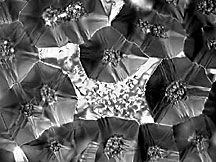 |
|---|
|
Arf! The team of the Condensed Matter Sciences Division’s Lynn Boatner and Metals & Ceramics Division’s Hu Longmire has produced many award-winning images but rarely one so canine in appearance. The image won second prize in the American Conference on Crystal Growth and Epitaxy's 16th Annual Crystal Photograph Competition. The unusual twinned crystals were formed during the thermochemical treatment of single crystals of zinc oxide. |
Users are mainly the safeguards and security departments within DOE and NNSA sites. Chris points out that a good seal system can make tasks like inventorying the special material—ORNL’s cache of uranium-233 is an example—a much smoother and cheaper process.
The tool has been a joint project between ORNL and Sandia National Laboratories and is funded by the DOE Office of Security and Safety Performance Assurance.
 Energy ‘rollback’ at Wal-Mart
Energy ‘rollback’ at Wal-Mart
If you want to get energy-efficient technologies into the mainstream, get the big players involved. That’s what DOE has done in teaming with Wal-Mart, the discount mega-chain. Wal-Mart recently showcased its “green” stores in McKinney, Texas. The Laboratory’s Buildings Technology Center, which develops and tests new construction and insulation materials designed for greater building energy efficiency, is monitoring energy systems in two Wal-Mart stores in the Dallas suburb over a three-year period.
BTC Director Jeff Christian says monitoring will be conducted in the two Wal-Mart stores, the newest one sporting 200 energy-efficiency sensors. The goal is to gain an energy cost savings equal to 40 percent of a store’s monthly energy cost.
The project with the nation’s most prominent retailer has attracted considerable attention, with coverage in major newspapers such as the Los Angeles Times and on National Public Radio.
—Reported by Bill Cabage and Eva Millwood |
 X-ray, neutron mirrors focus view into new materials
X-ray, neutron mirrors focus view into new materials
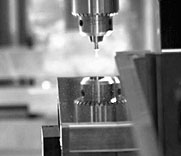 |
|---|
|
ORNL’s development of X-ray and neutron mirrors addresses a number of Office of Science research goals. |
Precision mirrors to focus X-rays and neutron beams could speed the path to new materials and perhaps help explain why computers, cell phones and satellites go on the blink.
In the last few years, a team led by Gene Ice of the Metals & Ceramics Division has improved by a factor of nearly 10 the performance of mirrors that enable researchers to examine variations in structure and chemistry and even individual nanoparticles. Information at this fine level is essential to understanding composition and structure of materials, and researchers continue to push the boundaries.
“There’s a worldwide race to develop high-performance mirrors that will dramatically expand the capabilities of major science facilities like the Advanced Photon Source and the Spallation Neutron Source,” says Gene. “We are now able to see in far greater detail the three-dimensional heterogeneous—or dissimilar—structure of materials and study internal interactions of one nanoparticle next to another.”
The stage was set a few years ago when the ORNL team developed differentially deposited X-ray micro-focusing mirrors. When installed on a beam line at the Advanced Photon Source at Argonne National Laboratory, these mirrors allowed researchers to obtain a resolution of 500 nanometers. One nanometer is equivalent to about three atoms in width. With recent advances in the optics and manufacturing processes, the ORNL team and collaborators at Argonne have now obtained a resolution of 70 nanometers. The ultimate goal is 1 nanometer.
The advantage of using mirrors instead of other techniques is that their focal properties are nearly independent of X-ray or neutron wavelengths. This allows them to be used to perform experiments that could not be done with other methods.
Neutron beams and X-rays both provide non-destructive testing of small samples of materials and allow scientists to examine grain boundary stresses, crystalline structure and orientation of the grains that make up material. Neutron beams probe deeper into a material and are especially useful for studying magnetic materials and structures with low atomic numbers—hydrogen, helium and carbon—while X-rays can examine individual nanoparticles.
The X-ray mirrors, which are similar to ones that received an R&D 100 award in 2000, are about 20 millimeters long, or about the size of a quarter. One mirror of the two-mirror system was fabricated using a differential polishing method while the other was made by profile coating an ultra-flat substrate. Both techniques produce monolithic optics more stable and more compact than is possible with dynamically bent mirror optics.
Neutron mirrors are much bigger—about 800 millimeters (31.5 inches) long—and increase the effectiveness of small neutron beams by a factor of about 100. Fabrication methods for neutron mirrors are further along than those for X-ray mirrors, which Ice describes as a work in progress. In both cases, precision is critical. The surface profile of an
X-ray mirror must be within 1/10th of a micro-radian, which, to put into perspective, is equivalent to a deviation of just 6/1,000ths of an inch over a mile, Gene says.
This research addresses a number of goals of DOE’s Office of Basic Energy Sciences, which seeks a better understanding of three-dimension grain growth, deformation of polycrystals and cracks at the so-called mesoscale—materials between 1/10th of a micron to hundreds of microns. With this knowledge, researchers hope to answer questions about electrical migration in interconnects within integrated circuits. Failures at this level lead to problems with electronic equipment in everything from automobiles to satellites.
Other ORNL researchers involved in the project are Ben Larson, John Budai and John Tischler of the Condensed Matter Sciences Division and Eliot Specht and Judy Pang of the M&C Division.—Ron Walli
 ORNL People
ORNL People
SNS Accelerator Systems Division Director Norbert Holtkamp has been named a senior member of the IEEE. Senior member is the IEEE’s highest professional grade, representing seven percent of the society’s 365,000 membership.
The Environmental Sciences Division’s Jizhong Zhou has been elected a fellow of the American Society for Microbiology for his pioneering advances and leadership in developing and applying integrated genomics technologies.
The Chemical Sciences Division’s Gary Van Berkel has been awarded the Biemann Medal by the American Society for Mass Spectrometry. The international award recognizes Gary’s electrospray ion source research, which greatly advances a key DOE mission to broaden the capabilities of mass spectrometry as it applies to homeland security, biology, drug discovery, nanotechnology and a host of other disciplines. ORNL’s Scott McLuckey earned the honor in 1997, the Biemann’s inaugural year, and no other national laboratory has captured this medal.
Amit Goyal has recently been elected a fllow of ASM International, “for outstanding and sustained contributions to processing of high temperature superconductors and to texture development and characterization in metals, alloys and ceramics. The Institute of Physics (IOP), United Kingdom, also elected Amit a fellow and, earlier this year, Amit became a fellow of the American Association for the Advancement of Science and the United Kingdom’s World Innovation Foundation.
Ray Boeman has been named manager of the Energy Efficiency and Renewable Energy Transportation Program and the National Transportation Research Center User Facility. Ray replaces Ed Grostick, who is retiring after 28 years of service. As transportation program manager, Ray will have primary responsibility for interacting with the DOE FreedomCAR and Vehicle Technologies Program.
John C. Doesburg has been named director of ORNL Homeland Security Programs. John retired from the Army as a major general, holding the position of commanding general of the U.S. Army Research, Development and Engineering Command. Since coming to the Lab he has worked very closely with the Biological and Environmental Sciences Directorate, helping to build programs in the chem-bio area.
Mark Reeves of the Technology Transfer and Economic Development Directorate has been elected regional coordinator of the Federal Laboratory Consortium for Technology Transfer, Southeast Region.
Glen Harrison of the Engineering S&T Division has been appointed to the Transportation Research Board’s Committee on Military Transportation, AT035.
Nageswara S. Rao of the Complex Systems Group, Computer Science and Mathematics Division, has been appointed as a new associate editor for Pattern Recognition Letters, published by Elsevier.
 Lab roundballers show their stripe by tipping off UW drive
Lab roundballers show their stripe by tipping off UW drive

|
|---|
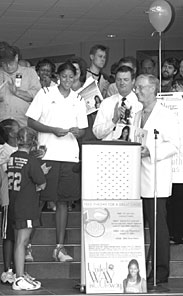 |
|---|
(From left) Two representatives from Girls Inc. of Oak Ridge, UT Lady Vol Candace Parker, ORNL Director Jeff Wadsworth and United Way Campaign Chair Lee Riedinger wrap up this year’s United Way tip-off festivities on the Research Office Building’s Main Street. Candace demonstrates her slam-dunk form in photo at right. |
Employees at ORNL may crack Dilbertesque jokes about physicists being the kings of wastebasketball, but on the afternoon of Wednesday, August 3, a few of the Lab’s finest scientists-cum-hoopsters got a chance to prove themselves at the real thing.
Hundreds of spectators crowded into the Research Office Building’s Main Street and surrounding stairwells to watch contestants in the United Way freethrow contest shoot it out for the 2005 ORNL United Way campaign “tip-off.” The guest of honor was Candace Parker of the Lady Vols basketball team.
One of the most highly-recruited University of Tennessee athletes of all time, Candace, a 6-3 forward, is the only two-time USA Today National Player of the Year, was twice chosen as both the Naismith and Gatorade Prep Player of the Year and was the first woman to win a slam-dunk contest, winning the 2004 PowerAde Jam Fest, part of the McDonald’s All-America Game festivities.
She gave the seven Lab contestants extra time for practice by arriving shortly after the scheduled 2 p.m. kickoff because of a class on the UT-Knoxville campus. “Everybody knows that Lady Vols never miss class, right?” cracked drive chairman Lee Riedinger, who served as the event’s master of ceremonies.
Candace didn’t miss class, but she did miss a chance to prove herself as the best free-throw shooter at the Lab that day. She made six out of 10 shots, while Tom King of Strategic Planning reigned over the afternoon with nine out of 10 shots in the contest, four out of five in the three-way-tie shootout with Jeff Thomas of Physics and Matt Smith of Research Reactors, and victory in the sudden-death elimination over Jeff.

|
|---|
The grand prize was the portable basketball goal used for the contest.
“Since my two boys already have a basket set up in the driveway, I’d like to donate this to Girls Inc.,” Tom said.
The Anderson County UW agency has unique ties to the Lady Volunteers. Nikki Caldwell, one of the team’s assistant coaches, grew up in Oak Ridge and participated in Girls Inc. before going on to play basketball at and graduate from UT. She is now a frequent guest and speaker at local events.
Tom’s generosity was the icing on the cake of the free-throw drive, which raised more than $1,600 for the United Way and kicked off the 2005 campaign at the Lab. Historically, ORNL has been the largest single contributing organization to the United Way, giving over $700,000 in 2004 alone. The funds raised by Lab employees are distributed to local human-service and assistance groups, boys’ and girls’ clubs, non-profit organizations and rehabilitation organizations.
UW volunteers see $$ at workORNL ambassadors and coordinators visited area United Way agencies to see how our dollars are helping. Here, Mary Beth Watt of the Facilities and Operations Directorate visits with a client in the arts and crafts center at Knoxville’s Cerebral Palsy Center.Tour participants also visited the Interfaith Health Clinic in the city. |
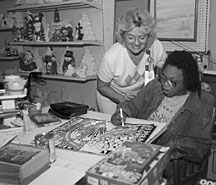 |
|---|
“United Way Is Our Way” is the theme for this year’s campaign.
Representatives of the Knox and Anderson county branches of the United Way attended the tip-off festivities as well, helping hand out door prizes and show their appreciation to each of the approximately 150 Lab employees who contributed money to the freethrow drive.
ORNL is regularly a national laboratory leader in giving to the United Way. This year’s campaign goal is $775,000. —Eva Millwood
 For strangers in a strange land, ORNL offers new club
For strangers in a strange land, ORNL offers new club
 |
|---|
|
Multicultural Friendship Club Coordinator Nancy Gray ponders the offer of a blueberry from Onni Bhaduri, son of ORNL researcher Budhu Bhaduri, at a recent MFC ice cream social. |
Foreign scientists and visitors at the Lab
and their families now have a new way to get a grasp on the United States, and Americans can celebrate the diversity of cultures at ORNL thanks to the creation of the Multicultural Friendship Club.
“Sometimes it’s hard for newcomers to find a new set of friends in a new country,” says International Services Coordinator Nancy Gray. “The purpose of the Multicultural Friendship Club is to demonstrate friendship to all citizens of the earth.”
Nancy, former ORNL protocol officer, is the first person to fill the international services coordinator position, which was created last year at the suggestion of Lab Director Jeff Wadsworth.
“It’s been a lot of fun for me,” Nancy says, explaining that cultural exchange and understanding is a personal passion as well as a professional goal. After taking her new position, Nancy traveled to colleges and universities and other national labs to get a feel for how those institutions approached the formation of international-personnel groups.
“A lot of scientists come here from foreign countries and never spend time in an American home,” Nancy says. “That is a great way for them to understand how Americans really live.” So far, MFC events have been held at public venues and private homes as well as Lab facilities to give the non-badged members of employees’ families a chance to participate as well.
“One Japanese couple said they liked baseball, so we organized a trip to a Smokies baseball game. More than more than 80 tickets sold for that event,” Nancy says.
Because the approximately 2,600 yearly foreign visitors and researchers at ORNL come from more than 75 different countries, part of the Lab’s focus is to provide social and cultural outlets for them. The MFC is a hub of cultural exchange for foreign-national and domestic Lab employees, because learning about other cultures is inherently a two-way street.
The MFC allows foreign nationals to learn about American culture, and also for American members to learn about other cultures and nationalities. Monthly brown-bag lunch lectures, which began in May and have so far been standing-room-only, have featured speakers from Indonesia, India, and Italy.
“If people are interested in a total cultural experience, this is an opportunity for them,” Nancy says.
The club has an organizing committee, but no dues or meeting requirements. During brown-bag lunches, which are open to everyone, there are always beverages and cookies and the cafeteria features cuisine of the country represented in the lecture. The club will have a presence at Community Day on August 27 and at the International Festival on September 27, and its events are always listed internally on ORNL Today. —Eva Millwood
 New Staff Members
New Staff Members
Craft Resources: Shane Burt, Reginald Chatman, Brandon Knight, Scott Jeffers, David Elliot, Tabitha Brooks, Drew Fye, James Kitchens, Benjamin Lefevers, Jesse Rollins, Benjamin Tan, Cassandra Woody, Jerry Wright, Daniel BrownSpallation Neutron Source: Timothy Carroll, Billy Joe Davis, David Gurd, Christine Schnell, Harry Sparks, Alexandru Stoica, Scott Tschaplinski, Christine Schnell, Shelly Ren, Luke Heroux, Stephen Brown, Saundra Carmon
Center for Computational Sciences: Arnold Tharrington, Ying Ding, Julia White, Sean Ahern
Human Resources: Connie Hughart, Katherine Finnie, Michael Palermo, Michelle Sykes
National Security Directorate: Ann Hasting, William Strunk, Kristy Herron, John Tanke
Engineering Science and Technology: Michael Schultze, Barry Daniel, Toby Flynn
Nuclear Science and Technology: Michelle Daugherty, Hatice Akkurt, Elisabeth Walker
Research Reactors: Diana Hackney, Tobias Pethel, Patrick Sanford
Metals and Ceramics: Brian Sparks, Claus Daniel
Environmental Protection and Waste Systems: Gerald Cunningham, Timothy Forrester
Computational Sciences and Engineering: Gregory Richardson, Larry Parker
Other new employees and their divisions are Roger Gregory, Operational Safety Services; Bonnie Hebert, Communications and External Relations; Robert Ezold, Facilities Management; Jeffrey Harris, Fusion Energy; Catherine Martin, Operational Safety Services; Jeffrey Parrott, Logistical Services; Cynthia Sonewald, Computer Science and Mathematics; Brandon Burke, Laboratory Protection; Paul Hebert, Office of Counterintelligence; Gary Baker, Chemical Sciences; Robin King, Legal; Kelly Kizer, Contracts; Latha Baskaran, Environmental Sciences
 Defibrillators deployed in Lab lifesaving campaign
Defibrillators deployed in Lab lifesaving campaign
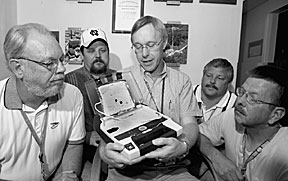 |
|---|
Kim Hardin, Hugh Christie, John Bumgardner, Bruce Whitaker and Randy Welch are trained to use the defibrillators stationed at the High Flux Isotope Reactor. |
ORNL’s neutron science community
promises to break new ground in the coming years. One area that it has broken ground already is in the installation of defibrillators at the High Flux Isotope Reactor and the Spallation Neutron Source.
Standard equipment in hospitals, automated external defibrillators—and trained users— can save the lives of heart attack victims in the field.
Defibrillators installed at the HFIR and SNS are the culmination of the first phase of an ORNL Health Services campaign to get the lifesaving devices installed around the Lab. The automated external defibrillators are used to jolt a cardiac arrest victim’s heart back into rhythm.
Defibrillators have been on the SNS construction site practically since the project began.
“They have been installed mainly because of the distance from the main campus and because of the high-voltage electrical work common at the site and the potential for a dangerous shock,” says Frank Kornegay, who directs ES&H for the SNS. “The defibrillators are very reliable. We put a lot of people through CPR courses. It just made good sense. Fortunately we haven’t had to use them.”
Around 30 HFIR staff members have been trained to use the devices, and Environment, Safety, Health and Quality Director Karen Downer is seeking more volunteers around the Lab who want to learn how to use these devices so that they can be deployed in more Lab work spaces. Two units are available now.
“Sudden cardiac arrest kills nearly half a million Americans each year, making it the number one health care problem and leading cause of death. Early defibrillation, within the first few minutes of a massive heart attack, could save many victims,” Karen says. “OSHA estimates that 15 percent of workplace fatalities are caused by sudden cardiac arrest, and 40 percent of those could have been saved by using the defibrillators within five minutes.”
ORNL Health Services Director Dr. James Phillips and F&O Director Herb Debban have championed the deployment of the defibrillators at the Lab.
“The most common cause of sudden cardiac arrest is ventricular fibrillation, a lethal arrhythmia characterized by rapid, chaotic contractions of the heart. Factors leading to it can include heart disease, electrocution, drowning, choking and other trauma,” Doc Phillips says. “It’s often sudden, unexpected and without warning. I’ve recommended these defibrillators for the Laboratory because of their lifesaving potential.”
Karen says that knowing how to perform cardiopulmonary resuscitation and how to use the defibrillators could very well make you a lifesaver. If you are interested in training on the use of automated external defibrillators, the process is outlined on ORNL’s Standards Based Management System.—B.C.
 More summer students
More summer students
In addition to the summer students listed in the July issue are these students in the Computational Physics and Engineering Division: Sirisha S. Nukala, Julia C. Carpenter, Maria Meyerovich, Symeon Hunter, David Thomas Potere, Adam Thompson, Benjamin Michael Lamie, James Louis Barnes, Lauren Anne Patterson, Matthew Woerner, Ali Mili, Anthony Matthew Filippi, Seong-Moo Yoo, Michael Sterling, Alexandre Sorokine, Aarthy Sabesan, Anil Meerasa Cheriyadat, Brooks Alan Jolly, Marie Lyn Minner, Nagendra Singh, Cindy J. Lopez, Elizabeth O’Quinn, Janel Tamara Brown, Jennifer Bennett, Jermaine Eugene Hemby, Kenroy Williamson, Rowena Ong, Deanna Lynn Britton and Jason Wilbur Cox.
Bill Cabage, editor, ORNL, 865/574-4399 (cabagewh@ornl.gov)
Deborah Barnes, associate editor, 865/576-0470 (barnesds@ornl.gov)
ORNL office: P.O. Box 2008, Oak Ridge, TN 37831-6146, Building 4500-S, Room F-60, MS 6146
News Deadlines
DOE inspector general hotline: 1-800-541-1625
[an error occurred while processing this directive] [an error occurred while processing this directive]
